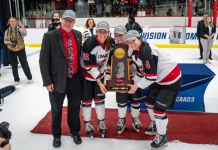I can remember my first exposure to the NHL Entry Draft. It was 1993 in the hockey hotbed of Old France — Quebec City.
I was in Quebec with my godparents, whose son was earmarked as a potential first-round pick. He had just come out of high school having attended one of the better-known prep schools. He would go on to a successful college career as an All-American blueliner — not too shabby.
But one of my most memorable experiences with this solid, 6-foot-2 defenseman wasn’t watching him on the ice, but rather watching him in Quebec draft weekend.
It was strange to me that such a young kid — only 18 at the time — was going through such a critical life-transforming event. His T-shirt, jeans and flip-flops were traded in for fancy suits, starched dress shirts and uncomfortable neck ties. In a few days, this incredibly fun-loving kid was becoming a man.
A hard-working, skilled player, this game that had been so much fun all his life was about to become a career. A business. Heck, the dress suit and the meetings (players often spend days interviewing with potential NHL teams before the draft) alone were enough to make it a business. Add in the agents, the phone calls from scouts and the like and you knew this wasn’t pee wees anymore.
The NHL is indeed a business. A big business. Right now, it’s a struggling big business, but that’s a story for another day. Its employees, though, often times are very young. Some are mature enough to handle the pressure; others are not.
— An NHL general manager on the Draft
The “system,” so to speak, works for many who enter it. In the old days (about 10-20 years ago) of the NHL, these employees mostly came from Canada. Junior hockey, still a thriving business in itself north of the border, was and in some ways still is a way of live for the young Canadian player. It’s not strange to know a 14- or 15-year old who leaves home to go play junior hockey in Canada, and for these players the development curve of maturity is likely accelerated.
But, in today’s day and age, the increasing trend is to forego the junior route in favor of college hockey, and therein lies an issue. The youngest college player is around 17, though typically your average hockey-playing freshman is 19. These players, in theory, hold a four-year commitment in front of them to not only play for their college team but, at the same time, to get an education and degree that will take them beyond the age of 30 when the average pro career comes to an end.
The system, though, particularly when it comes to the NHL draft, doesn’t support this level of development. I can’t sit here and point blame because I know that both the NCAA and the NHL create problems for themselves by not working together. With the NHL draft age set from 18 to 20 with 90 percent or more of the players opting-in (the official term for declaring themselves eligible) at age 18, those with college in their future generally have not even begun their college careers.
This puts strain on a host of different parties. NHL general managers are forced to play harbinger, picking a player sometimes five years before their college careers will end and they’ll even consider playing professionally. That five-year patience isn’t always attached for the GM, putting college coaches in the position of recruiting players knowing the possibility that the player will see all four seasons at the college level is rare.
“You almost don’t care,” said one NHL GM of selecting college players. “Most of these kids won’t even play for you for four or five years. How can we predict what kind of a player they’ll be in four or five years?”
“There’s a lot of pressure put on these kids at a very young age,” said an NHL player agent. “If you’re 18 years old and a top prospect, you may want to head to college and get an education.
“But two years later — if even that long — the NHL might come knocking on your door and want you to sign. What do you do then? It’s hard to turn down the money and the opportunity. For a lot of kids this is a dream come true.”
In the end, you have to recognize this as a system flawed. There’s little blame to hand out, though, mostly because the system and the process is ever evolving. But, right now, there’s an opportunity.
As most hockey fans are aware, the collective bargaining agreement (CBA) between the NHL and its players expires on Sept. 15. With talks of salary caps dominating discussion, one may not even realize that the terms of the Entry Draft, which includes ever-changing guidelines for college players, are part of this CBA.
If there is to be a solution (and I recognize there is likely no perfect one to this problem) the NCAA, the NHL and its Players Association need to work together to develop a guideline that works for everybody.
Times have changed. Gone are the days of only one path to the NHL. Education is just as important as a person’s playing career. That’s what the NHL needs to realize — and address.
(This article originally appeared in this month’s edition of USCHO Magazine.)


